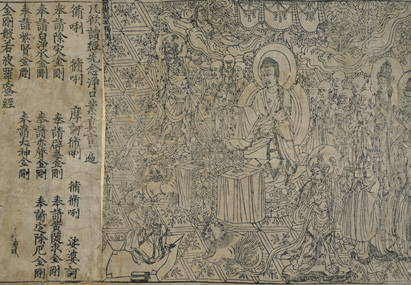An Illustrated Outline of Buddhism: The Essentials of Buddhist Spirituality (5 page)
Read An Illustrated Outline of Buddhism: The Essentials of Buddhist Spirituality Online
Authors: William Stoddart,Joseph A. Fitzgerald
Tags: #Philosophy

recognizing Ultimate Reality either as a Supreme State (
Nirvāna
)
or as
a Supreme Being (
Dharmakāya
).
In either case, the essential nature of
Ultimate Reality remains the same: it is absolute, infinite, and perfect.
Thus, in its conception of Ultimate Reality, Buddhism is essential y in
accord with every other world religion.
With this clarification in mind, let us formulate a definition of re-
ligion which will cover both Buddhism and the religions which are
explicitly theistic.
2 On
Dharmakāya
, see p. 50; on
Mahāvairochana
or
Ādi-Buddha
, see p. 72; on Amitābha, Amitāyus, and the “Pure Land” School, see pp. 55 and 79-80.
3
Theravāda
is the only surviving branch of
Hīnayāna
Buddhism. See p. 53.






Special Characteristics of Buddhism
3
There is an Unborn, Unoriginated, Uncreated, Unconditioned.
If that Unborn, Unoriginated, Uncreated, Unconditioned were
not, there could be no escape from this that is born, originated,
created, conditioned. But because there is That which is Unborn,
Unoriginated, Uncreated, Unconditioned, an escape from this
that is born, originated, created, conditioned can be proclaimed.
Khuddaka-Nikāya, Udāna, 80ff
Bronze statue of the Buddha, Tibet, 15th century



4
An Illustrated Outline of Buddhism
Vajrachchedikā-Sūtra
(the “Diamond Sūtra”),
ink on paper, China, 868 A.D.
Frontispiece of the
Prajñā-Pāramitā-Sūtra
, Japan, late 12th century
The mind endowed with intel igence is free from the intoxication
of sensuality, from the intoxication of things that change, from
the intoxication of ignorance.
Dīgha-Nikāya


5
(2) What is Religion?
In terms of etymology, religion is that which binds, specifical y, that
which binds man to God. Religion engages man in two ways: firstly,
by explaining the nature and meaning of the universe, or “justifying
the ways of God to man” (this is theodicy); and secondly, by elucidat-
ing man’s role and purpose in the universe, or teaching him how to
liberate himself from its limitations, constrictions, and terrors (this is
soteriology).
In the first place, religion is a doctrine of unity: God is one, and it
is He who is the origin and final end of the universe and of man in it.
Man, however, has become separated from God—through the “Fal ”
according to Christianity, through “ignorance” according to the Aryan
religions. Consequently, religion is also a way of “return”, a method of
union. It is a sacramental path, a means of salvation.
Whatever they may be called, these two components are always
present: theodicy and soteriology; doctrine and method; theory and
practice; dogma and sacrament; unity and union.
Doctrine, or theory, concerns the mind (or, at the highest level, the
“intellect”, in the precise metaphysical sense of the Medieval
Intel ectus
,
the Greek
Nous
,
or the Sanskrit
Buddhi
);
method, or practice, concerns the wil . Religion, to be itself, must always engage both mind and wil .
